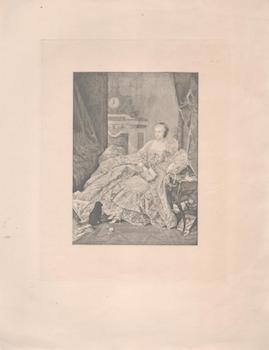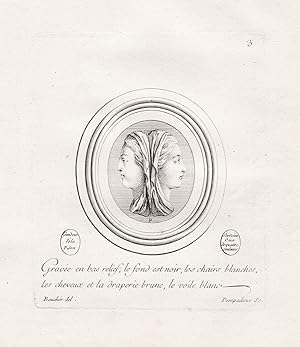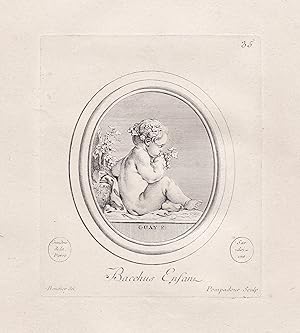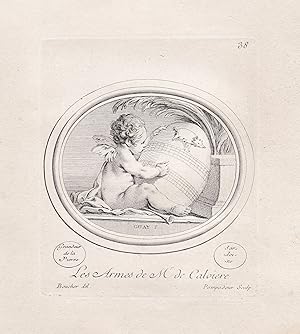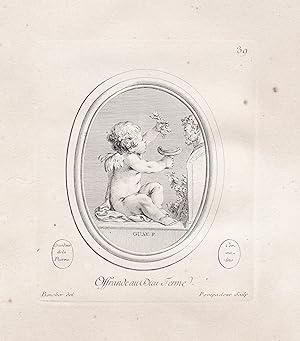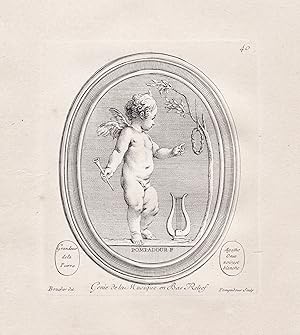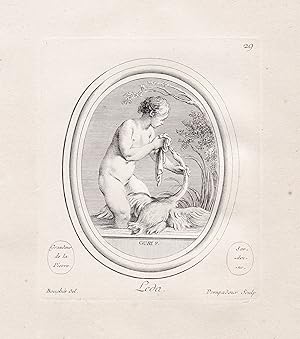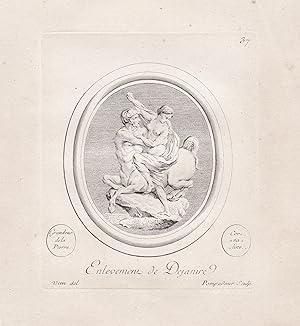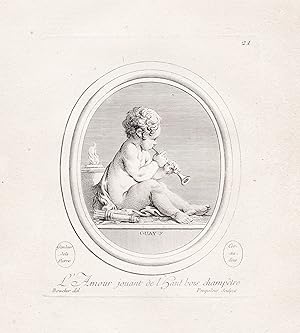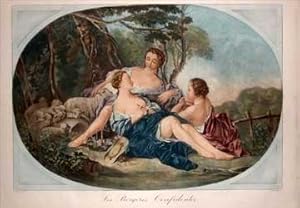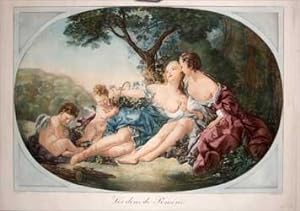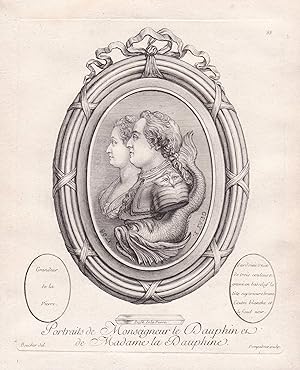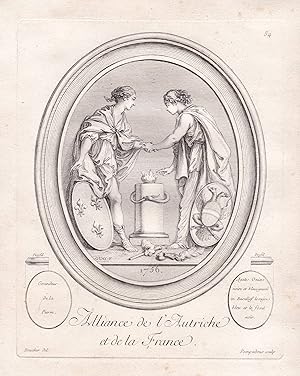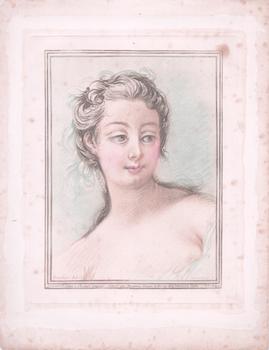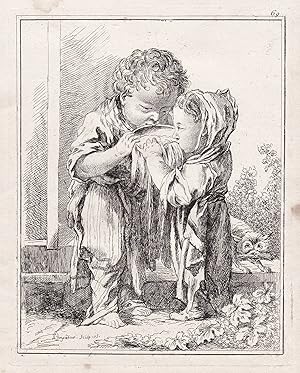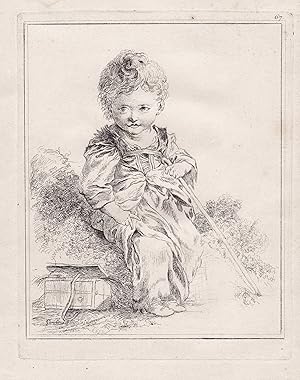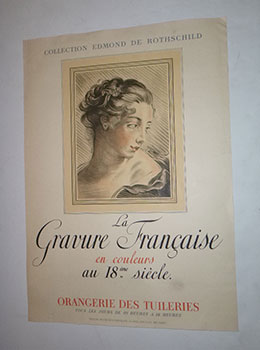Boucher, Francois After (25 results)
Product Type
- All Product Types
- Books (1)
- Magazines & Periodicals
- Comics
- Sheet Music
- Art, Prints & Posters (24)
- Photographs
- Maps
-
Manuscripts &
Paper Collectibles
Condition
- All Conditions
- New
- Used
Binding
- All Bindings
- Hardcover (1)
- Softcover
Collectible Attributes
- First Edition
- Signed
- Dust Jacket
- Seller-Supplied Images (22)
- Not Printed On Demand
Seller Location
Seller Rating
-
Madame de Pompadour.
Published by Paris: French Publisher, circa 1800., 1800
Seller: Wittenborn Art Books, San Francisco, CA, U.S.A.
Art / Print / Poster
Condition: Good. Etching and aquatint on laid paper. 33.2 x 25.8 cm. (sheet). Very Good, light toning along sheet edges.
-
Gravee en bas-relief, le fond est noir, les chairs blanches, les cheveux et la draperie brune, le voile blanc" - female faces / Ornament / women / Frauen / Portrait
Published by ca. 1775., 1775
Seller: Antiquariat Steffen Völkel GmbH, Seubersdorf, Germany
Art / Print / Poster
Sehr seltener Kupferstich aus der Serie "Suite d'Estampes gravees par Madame la Marquise de Pompadour d'apres les Pierres gravees de Guay" (ca. 1775). -- Blatt-Maße: ca. 28 x 21 cm. Platte: ca. 13 x 10,5 cm. -- im Außenrand teils leicht fleckig, sonst gut erhalten. || Very rare engraving from the series "Suite d'Estampes gravees par Madame la Marquise de Pompadour d'apres les Pierres gravees de Guay" (c. 1775). -- slightly stained on the outer margin, otherwise in good condition. || Madame de Pompadour, born Jeanne Antoinette Poisson (1721 1764), was a prominent member of the French court during the 18th century. She served as King Louis XV's official mistress from 1745 to 1751, and maintained her influence as a court favorite until her death. Despite facing political opposition and struggling with poor health, Pompadour took charge of the king's schedule and acted as a valuable aide and advisor. She also secured titles of nobility for herself and her relatives, while cultivating a network of clients and supporters that notably included the Queen, Marie Leszczynska. In the 1750s, Madame de Pompadour's role in the French court evolved from that of the King's mistress to that of his trusted confidante, although she still maintained significant influence over the king, acting often as an advisor as well. She relocated to the ground floor of the Palace in 1751 and focused on patronizing the arts and overseeing new construction projects. In 1756, she played a pivotal role in the establishment of the royal porcelain factory at Sèvres and the creation of Place Louis XV (Place de la Concorde). She also convinced the King, with the help of her brother, to build the Petit Trianon. Madame de Pompadour enjoyed nurtureing her intellect and supported the publication of the first two volumes of Diderot and d'Alembert's Encyclopaedia in 1751. In 1753, Louis XV purchased the Hôtel d'Evreux (now the Elysée Palace) for Madame de Pompadour to use as a residence during her visits to Paris. She split her time between the capital and the Palace of Bellevue in Meudon until her death from tuberculosis at the age of 42 in Versailles in 1764. The King was deeply affected by her death. As a patron of the arts, Pompadour supported architecture, decorative arts, and porcelain. She was also a prominent patron of Enlightenment philosophers like Voltaire. Despite criticism from some of her contemporaries who viewed her as a malevolent political influence, modern historians generally view her more positively, highlighting her successes as a champion of French pride and as a woman who rose to power and influence despite not being born into the aristocracy. Some historians argue that Pompadour's critics were motivated by a fear of the social and gender hierarchies she challenged. Sprache: Französisch Gewicht in Gramm: 10.
-
Victoire de Lutzelberg" - Battle of Lutterberg (1758) / Bataille de Lutzelberg / Schlacht bei Lutterberg
Published by Paris ca. 1775., 1775
Seller: Antiquariat Steffen Völkel GmbH, Seubersdorf, Germany
Art / Print / Poster
Sehr seltener Kupferstich aus der Serie "Suite d'Estampes gravees par Madame la Marquise de Pompadour d'apres les Pierres gravées de Guay" (ca. 1775). -- Blatt-Maße: ca. 17,5 x 14,5 cm. Platte: ca. 15 x 12,5 cm. -- gut erhalten. || Very rare engraving from the series "Suite d'Estampes gravees par Madame la Marquise de Pompadour d'apres les Pierres gravees de Guay" (c. 1775). -- in very good condition. || Madame de Pompadour, born Jeanne Antoinette Poisson (1721 1764), was a prominent member of the French court during the 18th century. She served as King Louis XV's official mistress from 1745 to 1751, and maintained her influence as a court favorite until her death. Despite facing political opposition and struggling with poor health, Pompadour took charge of the king's schedule and acted as a valuable aide and advisor. She also secured titles of nobility for herself and her relatives, while cultivating a network of clients and supporters that notably included the Queen, Marie Leszczynska. In the 1750s, Madame de Pompadour's role in the French court evolved from that of the King's mistress to that of his trusted confidante, although she still maintained significant influence over the king, acting often as an advisor as well. She relocated to the ground floor of the Palace in 1751 and focused on patronizing the arts and overseeing new construction projects. In 1756, she played a pivotal role in the establishment of the royal porcelain factory at Sèvres and the creation of Place Louis XV (Place de la Concorde). She also convinced the King, with the help of her brother, to build the Petit Trianon. Madame de Pompadour enjoyed nurtureing her intellect and supported the publication of the first two volumes of Diderot and d'Alembert's Encyclopaedia in 1751. In 1753, Louis XV purchased the Hôtel d'Evreux (now the Elysée Palace) for Madame de Pompadour to use as a residence during her visits to Paris. She split her time between the capital and the Palace of Bellevue in Meudon until her death from tuberculosis at the age of 42 in Versailles in 1764. The King was deeply affected by her death. As a patron of the arts, Pompadour supported architecture, decorative arts, and porcelain. She was also a prominent patron of Enlightenment philosophers like Voltaire. Despite criticism from some of her contemporaries who viewed her as a malevolent political influence, modern historians generally view her more positively, highlighting her successes as a champion of French pride and as a woman who rose to power and influence despite not being born into the aristocracy. Some historians argue that Pompadour's critics were motivated by a fear of the social and gender hierarchies she challenged. Sprache: Französisch Gewicht in Gramm: 10.
-
Pretre Egyptien" - Egyptian priest / Ägyptischer Priester / Egypt / Ägypten
Published by Paris ca. 1775., 1775
Seller: Antiquariat Steffen Völkel GmbH, Seubersdorf, Germany
Art / Print / Poster
Sehr seltener Kupferstich aus der Serie "Suite d'Estampes gravees par Madame la Marquise de Pompadour d'apres les Pierres gravées de Guay" (ca. 1775). -- Blatt-Maße: ca. 18 x 16 cm. Platte: ca. 35 x 10,5 cm. -- nur leicht fleckig, sonst gut erhalten. || Very rare engraving from the series "Suite d'Estampes gravees par Madame la Marquise de Pompadour d'apres les Pierres gravees de Guay" (c. 1775). -- only slightly stained, otherwise in very good condition. || Madame de Pompadour, born Jeanne Antoinette Poisson (1721 1764), was a prominent member of the French court during the 18th century. She served as King Louis XV's official mistress from 1745 to 1751, and maintained her influence as a court favorite until her death. Despite facing political opposition and struggling with poor health, Pompadour took charge of the king's schedule and acted as a valuable aide and advisor. She also secured titles of nobility for herself and her relatives, while cultivating a network of clients and supporters that notably included the Queen, Marie Leszczynska. In the 1750s, Madame de Pompadour's role in the French court evolved from that of the King's mistress to that of his trusted confidante, although she still maintained significant influence over the king, acting often as an advisor as well. She relocated to the ground floor of the Palace in 1751 and focused on patronizing the arts and overseeing new construction projects. In 1756, she played a pivotal role in the establishment of the royal porcelain factory at Sèvres and the creation of Place Louis XV (Place de la Concorde). She also convinced the King, with the help of her brother, to build the Petit Trianon. Madame de Pompadour enjoyed nurtureing her intellect and supported the publication of the first two volumes of Diderot and d'Alembert's Encyclopaedia in 1751. In 1753, Louis XV purchased the Hôtel d'Evreux (now the Elysée Palace) for Madame de Pompadour to use as a residence during her visits to Paris. She split her time between the capital and the Palace of Bellevue in Meudon until her death from tuberculosis at the age of 42 in Versailles in 1764. The King was deeply affected by her death. As a patron of the arts, Pompadour supported architecture, decorative arts, and porcelain. She was also a prominent patron of Enlightenment philosophers like Voltaire. Despite criticism from some of her contemporaries who viewed her as a malevolent political influence, modern historians generally view her more positively, highlighting her successes as a champion of French pride and as a woman who rose to power and influence despite not being born into the aristocracy. Some historians argue that Pompadour's critics were motivated by a fear of the social and gender hierarchies she challenged. Sprache: Französisch Gewicht in Gramm: 10.
-
Bacchus enfant" - Bacchus as a child / Dionysus / mythology / Mythologie
Published by Paris ca. 1775., 1775
Seller: Antiquariat Steffen Völkel GmbH, Seubersdorf, Germany
Art / Print / Poster
Sehr seltener Kupferstich aus der Serie "Suite d'Estampes gravees par Madame la Marquise de Pompadour d'apres les Pierres gravées de Guay" (ca. 1775). -- Blatt-Maße: ca. 18 x 15,5 cm. Platte: ca. 13 x 10,5 cm. -- gut erhalten. || Very rare engraving from the series "Suite d'Estampes gravees par Madame la Marquise de Pompadour d'apres les Pierres gravees de Guay" (c. 1775). -- in very good condition. || Madame de Pompadour, born Jeanne Antoinette Poisson (1721 1764), was a prominent member of the French court during the 18th century. She served as King Louis XV's official mistress from 1745 to 1751, and maintained her influence as a court favorite until her death. Despite facing political opposition and struggling with poor health, Pompadour took charge of the king's schedule and acted as a valuable aide and advisor. She also secured titles of nobility for herself and her relatives, while cultivating a network of clients and supporters that notably included the Queen, Marie Leszczynska. In the 1750s, Madame de Pompadour's role in the French court evolved from that of the King's mistress to that of his trusted confidante, although she still maintained significant influence over the king, acting often as an advisor as well. She relocated to the ground floor of the Palace in 1751 and focused on patronizing the arts and overseeing new construction projects. In 1756, she played a pivotal role in the establishment of the royal porcelain factory at Sèvres and the creation of Place Louis XV (Place de la Concorde). She also convinced the King, with the help of her brother, to build the Petit Trianon. Madame de Pompadour enjoyed nurtureing her intellect and supported the publication of the first two volumes of Diderot and d'Alembert's Encyclopaedia in 1751. In 1753, Louis XV purchased the Hôtel d'Evreux (now the Elysée Palace) for Madame de Pompadour to use as a residence during her visits to Paris. She split her time between the capital and the Palace of Bellevue in Meudon until her death from tuberculosis at the age of 42 in Versailles in 1764. The King was deeply affected by her death. As a patron of the arts, Pompadour supported architecture, decorative arts, and porcelain. She was also a prominent patron of Enlightenment philosophers like Voltaire. Despite criticism from some of her contemporaries who viewed her as a malevolent political influence, modern historians generally view her more positively, highlighting her successes as a champion of French pride and as a woman who rose to power and influence despite not being born into the aristocracy. Some historians argue that Pompadour's critics were motivated by a fear of the social and gender hierarchies she challenged. Sprache: Französisch Gewicht in Gramm: 10.
-
Les Armes de Mr. de Calviere" - putto / putti / Amor / Eros / Mythology / Mythologie
Published by Paris ca. 1775., 1775
Seller: Antiquariat Steffen Völkel GmbH, Seubersdorf, Germany
Art / Print / Poster
Sehr seltener Kupferstich aus der Serie "Suite d'Estampes gravees par Madame la Marquise de Pompadour d'apres les Pierres gravées de Guay" (ca. 1775). -- Blatt-Maße: ca. 18 x 15,5 cm. Platte: ca. 13 x 10,5 cm. -- gut erhalten. || Very rare engraving from the series "Suite d'Estampes gravees par Madame la Marquise de Pompadour d'apres les Pierres gravees de Guay" (c. 1775). -- in very good condition. || Madame de Pompadour, born Jeanne Antoinette Poisson (1721 1764), was a prominent member of the French court during the 18th century. She served as King Louis XV's official mistress from 1745 to 1751, and maintained her influence as a court favorite until her death. Despite facing political opposition and struggling with poor health, Pompadour took charge of the king's schedule and acted as a valuable aide and advisor. She also secured titles of nobility for herself and her relatives, while cultivating a network of clients and supporters that notably included the Queen, Marie Leszczynska. In the 1750s, Madame de Pompadour's role in the French court evolved from that of the King's mistress to that of his trusted confidante, although she still maintained significant influence over the king, acting often as an advisor as well. She relocated to the ground floor of the Palace in 1751 and focused on patronizing the arts and overseeing new construction projects. In 1756, she played a pivotal role in the establishment of the royal porcelain factory at Sèvres and the creation of Place Louis XV (Place de la Concorde). She also convinced the King, with the help of her brother, to build the Petit Trianon. Madame de Pompadour enjoyed nurtureing her intellect and supported the publication of the first two volumes of Diderot and d'Alembert's Encyclopaedia in 1751. In 1753, Louis XV purchased the Hôtel d'Evreux (now the Elysée Palace) for Madame de Pompadour to use as a residence during her visits to Paris. She split her time between the capital and the Palace of Bellevue in Meudon until her death from tuberculosis at the age of 42 in Versailles in 1764. The King was deeply affected by her death. As a patron of the arts, Pompadour supported architecture, decorative arts, and porcelain. She was also a prominent patron of Enlightenment philosophers like Voltaire. Despite criticism from some of her contemporaries who viewed her as a malevolent political influence, modern historians generally view her more positively, highlighting her successes as a champion of French pride and as a woman who rose to power and influence despite not being born into the aristocracy. Some historians argue that Pompadour's critics were motivated by a fear of the social and gender hierarchies she challenged. Sprache: Französisch Gewicht in Gramm: 10.
-
Offrande au Dieu Terme" - putto / putti / Amor / Eros / Sacrifice / Mythology / Mythologie
Published by Paris ca. 1775., 1775
Seller: Antiquariat Steffen Völkel GmbH, Seubersdorf, Germany
Art / Print / Poster
Sehr seltener Kupferstich aus der Serie "Suite d'Estampes gravees par Madame la Marquise de Pompadour d'apres les Pierres gravées de Guay" (ca. 1775). -- Blatt-Maße: ca. 18 x 15,5 cm. Platte: ca. 13 x 10,5 cm. -- leicht fleckig, sonst gut erhalten. || Very rare engraving from the series "Suite d'Estampes gravees par Madame la Marquise de Pompadour d'apres les Pierres gravees de Guay" (c. 1775). -- slightly stained, otherwise in very good condition. || Madame de Pompadour, born Jeanne Antoinette Poisson (1721 1764), was a prominent member of the French court during the 18th century. She served as King Louis XV's official mistress from 1745 to 1751, and maintained her influence as a court favorite until her death. Despite facing political opposition and struggling with poor health, Pompadour took charge of the king's schedule and acted as a valuable aide and advisor. She also secured titles of nobility for herself and her relatives, while cultivating a network of clients and supporters that notably included the Queen, Marie Leszczynska. In the 1750s, Madame de Pompadour's role in the French court evolved from that of the King's mistress to that of his trusted confidante, although she still maintained significant influence over the king, acting often as an advisor as well. She relocated to the ground floor of the Palace in 1751 and focused on patronizing the arts and overseeing new construction projects. In 1756, she played a pivotal role in the establishment of the royal porcelain factory at Sèvres and the creation of Place Louis XV (Place de la Concorde). She also convinced the King, with the help of her brother, to build the Petit Trianon. Madame de Pompadour enjoyed nurtureing her intellect and supported the publication of the first two volumes of Diderot and d'Alembert's Encyclopaedia in 1751. In 1753, Louis XV purchased the Hôtel d'Evreux (now the Elysée Palace) for Madame de Pompadour to use as a residence during her visits to Paris. She split her time between the capital and the Palace of Bellevue in Meudon until her death from tuberculosis at the age of 42 in Versailles in 1764. The King was deeply affected by her death. As a patron of the arts, Pompadour supported architecture, decorative arts, and porcelain. She was also a prominent patron of Enlightenment philosophers like Voltaire. Despite criticism from some of her contemporaries who viewed her as a malevolent political influence, modern historians generally view her more positively, highlighting her successes as a champion of French pride and as a woman who rose to power and influence despite not being born into the aristocracy. Some historians argue that Pompadour's critics were motivated by a fear of the social and gender hierarchies she challenged. Sprache: Französisch Gewicht in Gramm: 10.
-
Genie de la Musique en Bas relief" - Spirit of music / personification / Musik / harp / Harfe / flute / Flöte
Published by Paris ca. 1775., 1775
Seller: Antiquariat Steffen Völkel GmbH, Seubersdorf, Germany
Art / Print / Poster
Sehr seltener Kupferstich aus der Serie "Suite d'Estampes gravees par Madame la Marquise de Pompadour d'apres les Pierres gravées de Guay" (ca. 1775). -- Blatt-Maße: ca. 18 x 15,5 cm. Platte: ca. 13 x 10,5 cm. -- gut erhalten. || Very rare engraving from the series "Suite d'Estampes gravees par Madame la Marquise de Pompadour d'apres les Pierres gravees de Guay" (c. 1775). -- in very good condition. || Madame de Pompadour, born Jeanne Antoinette Poisson (1721 1764), was a prominent member of the French court during the 18th century. She served as King Louis XV's official mistress from 1745 to 1751, and maintained her influence as a court favorite until her death. Despite facing political opposition and struggling with poor health, Pompadour took charge of the king's schedule and acted as a valuable aide and advisor. She also secured titles of nobility for herself and her relatives, while cultivating a network of clients and supporters that notably included the Queen, Marie Leszczynska. In the 1750s, Madame de Pompadour's role in the French court evolved from that of the King's mistress to that of his trusted confidante, although she still maintained significant influence over the king, acting often as an advisor as well. She relocated to the ground floor of the Palace in 1751 and focused on patronizing the arts and overseeing new construction projects. In 1756, she played a pivotal role in the establishment of the royal porcelain factory at Sèvres and the creation of Place Louis XV (Place de la Concorde). She also convinced the King, with the help of her brother, to build the Petit Trianon. Madame de Pompadour enjoyed nurtureing her intellect and supported the publication of the first two volumes of Diderot and d'Alembert's Encyclopaedia in 1751. In 1753, Louis XV purchased the Hôtel d'Evreux (now the Elysée Palace) for Madame de Pompadour to use as a residence during her visits to Paris. She split her time between the capital and the Palace of Bellevue in Meudon until her death from tuberculosis at the age of 42 in Versailles in 1764. The King was deeply affected by her death. As a patron of the arts, Pompadour supported architecture, decorative arts, and porcelain. She was also a prominent patron of Enlightenment philosophers like Voltaire. Despite criticism from some of her contemporaries who viewed her as a malevolent political influence, modern historians generally view her more positively, highlighting her successes as a champion of French pride and as a woman who rose to power and influence despite not being born into the aristocracy. Some historians argue that Pompadour's critics were motivated by a fear of the social and gender hierarchies she challenged. Sprache: Französisch Gewicht in Gramm: 10.
-
Leda" - Leda and the swan / Schwan / Mythologie mythology
Published by Paris ca. 1775., 1775
Seller: Antiquariat Steffen Völkel GmbH, Seubersdorf, Germany
Art / Print / Poster
Sehr seltener Kupferstich aus der Serie "Suite d'Estampes gravees par Madame la Marquise de Pompadour d'apres les Pierres gravées de Guay" (ca. 1775). -- Blatt-Maße: ca. 18 x 15,5 cm. Platte: ca. 13 x 10,5 cm. -- gut erhalten. || Very rare engraving from the series "Suite d'Estampes gravees par Madame la Marquise de Pompadour d'apres les Pierres gravees de Guay" (c. 1775). -- in very good condition. || Madame de Pompadour, born Jeanne Antoinette Poisson (1721 1764), was a prominent member of the French court during the 18th century. She served as King Louis XV's official mistress from 1745 to 1751, and maintained her influence as a court favorite until her death. Despite facing political opposition and struggling with poor health, Pompadour took charge of the king's schedule and acted as a valuable aide and advisor. She also secured titles of nobility for herself and her relatives, while cultivating a network of clients and supporters that notably included the Queen, Marie Leszczynska. In the 1750s, Madame de Pompadour's role in the French court evolved from that of the King's mistress to that of his trusted confidante, although she still maintained significant influence over the king, acting often as an advisor as well. She relocated to the ground floor of the Palace in 1751 and focused on patronizing the arts and overseeing new construction projects. In 1756, she played a pivotal role in the establishment of the royal porcelain factory at Sèvres and the creation of Place Louis XV (Place de la Concorde). She also convinced the King, with the help of her brother, to build the Petit Trianon. Madame de Pompadour enjoyed nurtureing her intellect and supported the publication of the first two volumes of Diderot and d'Alembert's Encyclopaedia in 1751. In 1753, Louis XV purchased the Hôtel d'Evreux (now the Elysée Palace) for Madame de Pompadour to use as a residence during her visits to Paris. She split her time between the capital and the Palace of Bellevue in Meudon until her death from tuberculosis at the age of 42 in Versailles in 1764. The King was deeply affected by her death. As a patron of the arts, Pompadour supported architecture, decorative arts, and porcelain. She was also a prominent patron of Enlightenment philosophers like Voltaire. Despite criticism from some of her contemporaries who viewed her as a malevolent political influence, modern historians generally view her more positively, highlighting her successes as a champion of French pride and as a woman who rose to power and influence despite not being born into the aristocracy. Some historians argue that Pompadour's critics were motivated by a fear of the social and gender hierarchies she challenged. Sprache: Französisch Gewicht in Gramm: 10.
-
Enlevement de Dejanire" - Abduction of Deianira / Entführung von Deianeira durch den Zentauren Nessus / mythology / Mythologie
Published by Paris ca. 1775., 1775
Seller: Antiquariat Steffen Völkel GmbH, Seubersdorf, Germany
Art / Print / Poster
Sehr seltener Kupferstich aus der Serie "Suite d'Estampes gravees par Madame la Marquise de Pompadour d'apres les Pierres gravées de Guay" (ca. 1775). -- Blatt-Maße: ca. 18 x 15,5 cm. Platte: ca. 13 x 10,5 cm. -- gut erhalten. || Very rare engraving from the series "Suite d'Estampes gravees par Madame la Marquise de Pompadour d'apres les Pierres gravees de Guay" (c. 1775). -- in very good condition. || Madame de Pompadour, born Jeanne Antoinette Poisson (1721 1764), was a prominent member of the French court during the 18th century. She served as King Louis XV's official mistress from 1745 to 1751, and maintained her influence as a court favorite until her death. Despite facing political opposition and struggling with poor health, Pompadour took charge of the king's schedule and acted as a valuable aide and advisor. She also secured titles of nobility for herself and her relatives, while cultivating a network of clients and supporters that notably included the Queen, Marie Leszczynska. In the 1750s, Madame de Pompadour's role in the French court evolved from that of the King's mistress to that of his trusted confidante, although she still maintained significant influence over the king, acting often as an advisor as well. She relocated to the ground floor of the Palace in 1751 and focused on patronizing the arts and overseeing new construction projects. In 1756, she played a pivotal role in the establishment of the royal porcelain factory at Sèvres and the creation of Place Louis XV (Place de la Concorde). She also convinced the King, with the help of her brother, to build the Petit Trianon. Madame de Pompadour enjoyed nurtureing her intellect and supported the publication of the first two volumes of Diderot and d'Alembert's Encyclopaedia in 1751. In 1753, Louis XV purchased the Hôtel d'Evreux (now the Elysée Palace) for Madame de Pompadour to use as a residence during her visits to Paris. She split her time between the capital and the Palace of Bellevue in Meudon until her death from tuberculosis at the age of 42 in Versailles in 1764. The King was deeply affected by her death. As a patron of the arts, Pompadour supported architecture, decorative arts, and porcelain. She was also a prominent patron of Enlightenment philosophers like Voltaire. Despite criticism from some of her contemporaries who viewed her as a malevolent political influence, modern historians generally view her more positively, highlighting her successes as a champion of French pride and as a woman who rose to power and influence despite not being born into the aristocracy. Some historians argue that Pompadour's critics were motivated by a fear of the social and gender hierarchies she challenged. Sprache: Französisch Gewicht in Gramm: 10.
-
L'Amour jouant de l'Gaut bois champetre" - Amor / Amour / Eros / Mythologie / mythology
Published by Paris ca. 1775., 1775
Seller: Antiquariat Steffen Völkel GmbH, Seubersdorf, Germany
Art / Print / Poster
Sehr seltener Kupferstich aus der Serie "Suite d'Estampes gravees par Madame la Marquise de Pompadour d'apres les Pierres gravées de Guay" (ca. 1775). -- Blatt-Maße: ca. 18 x 15,5 cm. Platte: ca. 13 x 10,5 cm. -- gut erhalten. || Very rare engraving from the series "Suite d'Estampes gravees par Madame la Marquise de Pompadour d'apres les Pierres gravees de Guay" (c. 1775). -- in very good condition. || Madame de Pompadour, born Jeanne Antoinette Poisson (1721 1764), was a prominent member of the French court during the 18th century. She served as King Louis XV's official mistress from 1745 to 1751, and maintained her influence as a court favorite until her death. Despite facing political opposition and struggling with poor health, Pompadour took charge of the king's schedule and acted as a valuable aide and advisor. She also secured titles of nobility for herself and her relatives, while cultivating a network of clients and supporters that notably included the Queen, Marie Leszczynska. In the 1750s, Madame de Pompadour's role in the French court evolved from that of the King's mistress to that of his trusted confidante, although she still maintained significant influence over the king, acting often as an advisor as well. She relocated to the ground floor of the Palace in 1751 and focused on patronizing the arts and overseeing new construction projects. In 1756, she played a pivotal role in the establishment of the royal porcelain factory at Sèvres and the creation of Place Louis XV (Place de la Concorde). She also convinced the King, with the help of her brother, to build the Petit Trianon. Madame de Pompadour enjoyed nurtureing her intellect and supported the publication of the first two volumes of Diderot and d'Alembert's Encyclopaedia in 1751. In 1753, Louis XV purchased the Hôtel d'Evreux (now the Elysée Palace) for Madame de Pompadour to use as a residence during her visits to Paris. She split her time between the capital and the Palace of Bellevue in Meudon until her death from tuberculosis at the age of 42 in Versailles in 1764. The King was deeply affected by her death. As a patron of the arts, Pompadour supported architecture, decorative arts, and porcelain. She was also a prominent patron of Enlightenment philosophers like Voltaire. Despite criticism from some of her contemporaries who viewed her as a malevolent political influence, modern historians generally view her more positively, highlighting her successes as a champion of French pride and as a woman who rose to power and influence despite not being born into the aristocracy. Some historians argue that Pompadour's critics were motivated by a fear of the social and gender hierarchies she challenged. Sprache: Französisch Gewicht in Gramm: 10.
-
Les Bergèes confidentes.
Published by A. Gautier., 1793
Seller: Wittenborn Art Books, San Francisco, CA, U.S.A.
Art / Print / Poster
Condition: Good. Color engraving. 30 x 40 cm.
-
Le Repos de Diane.
Published by J. Massard, 18th cent.
Seller: Wittenborn Art Books, San Francisco, CA, U.S.A.
Art / Print / Poster
Condition: Good. Color engraving. 14 x 18 inches.
-
Les dons de Pomone.
Published by H. Gautier, 18th cent.
Seller: Wittenborn Art Books, San Francisco, CA, U.S.A.
Art / Print / Poster
Condition: Good. Color engraving. 30 x 40 cm. [One copy adhered to cardboard mount.].
-
Le Repos de Vénus.
Published by J. Massard, 18th cent.
Seller: Wittenborn Art Books, San Francisco, CA, U.S.A.
Art / Print / Poster
Condition: Good. Color engraving. 14 x 18 inches.
-
Portraits de Monseigneur le Dauphin et de Madame la Dauphine
Published by Paris ca. 1775., 1775
Seller: Antiquariat Steffen Völkel GmbH, Seubersdorf, Germany
Art / Print / Poster
Sehr seltener Kupferstich aus der Serie "Suite d'Estampes gravees par Madame la Marquise de Pompadour d'apres les Pierres gravées de Guay" (ca. 1775). -- Blatt-Maße: ca. 23 x 18 cm. Platte: ca. 20 x 16 cm. -- gut erhalten. || Very rare engraving from the series "Suite d'Estampes gravees par Madame la Marquise de Pompadour d'apres les Pierres gravees de Guay" (c. 1775). -- in very good condition. || Madame de Pompadour, born Jeanne Antoinette Poisson (1721 1764), was a prominent member of the French court during the 18th century. She served as King Louis XV's official mistress from 1745 to 1751, and maintained her influence as a court favorite until her death. Despite facing political opposition and struggling with poor health, Pompadour took charge of the king's schedule and acted as a valuable aide and advisor. She also secured titles of nobility for herself and her relatives, while cultivating a network of clients and supporters that notably included the Queen, Marie Leszczynska. In the 1750s, Madame de Pompadour's role in the French court evolved from that of the King's mistress to that of his trusted confidante, although she still maintained significant influence over the king, acting often as an advisor as well. She relocated to the ground floor of the Palace in 1751 and focused on patronizing the arts and overseeing new construction projects. In 1756, she played a pivotal role in the establishment of the royal porcelain factory at Sèvres and the creation of Place Louis XV (Place de la Concorde). She also convinced the King, with the help of her brother, to build the Petit Trianon. Madame de Pompadour enjoyed nurtureing her intellect and supported the publication of the first two volumes of Diderot and d'Alembert's Encyclopaedia in 1751. In 1753, Louis XV purchased the Hôtel d'Evreux (now the Elysée Palace) for Madame de Pompadour to use as a residence during her visits to Paris. She split her time between the capital and the Palace of Bellevue in Meudon until her death from tuberculosis at the age of 42 in Versailles in 1764. The King was deeply affected by her death. As a patron of the arts, Pompadour supported architecture, decorative arts, and porcelain. She was also a prominent patron of Enlightenment philosophers like Voltaire. Despite criticism from some of her contemporaries who viewed her as a malevolent political influence, modern historians generally view her more positively, highlighting her successes as a champion of French pride and as a woman who rose to power and influence despite not being born into the aristocracy. Some historians argue that Pompadour's critics were motivated by a fear of the social and gender hierarchies she challenged. Sprache: Französisch Gewicht in Gramm: 10.
-
Alliance de l'Autriche et de la France
Published by Paris ca. 1775., 1775
Seller: Antiquariat Steffen Völkel GmbH, Seubersdorf, Germany
Art / Print / Poster
Sehr seltener Kupferstich aus der Serie "Suite d'Estampes gravees par Madame la Marquise de Pompadour d'apres les Pierres gravées de Guay" (ca. 1775). -- Blatt-Maße: ca. 23 x 18 cm. Platte: ca. 20 x 16 cm. -- gut erhalten. || Very rare engraving from the series "Suite d'Estampes gravees par Madame la Marquise de Pompadour d'apres les Pierres gravees de Guay" (c. 1775). -- in very good condition. || Madame de Pompadour, born Jeanne Antoinette Poisson (1721 1764), was a prominent member of the French court during the 18th century. She served as King Louis XV's official mistress from 1745 to 1751, and maintained her influence as a court favorite until her death. Despite facing political opposition and struggling with poor health, Pompadour took charge of the king's schedule and acted as a valuable aide and advisor. She also secured titles of nobility for herself and her relatives, while cultivating a network of clients and supporters that notably included the Queen, Marie Leszczynska. In the 1750s, Madame de Pompadour's role in the French court evolved from that of the King's mistress to that of his trusted confidante, although she still maintained significant influence over the king, acting often as an advisor as well. She relocated to the ground floor of the Palace in 1751 and focused on patronizing the arts and overseeing new construction projects. In 1756, she played a pivotal role in the establishment of the royal porcelain factory at Sèvres and the creation of Place Louis XV (Place de la Concorde). She also convinced the King, with the help of her brother, to build the Petit Trianon. Madame de Pompadour enjoyed nurtureing her intellect and supported the publication of the first two volumes of Diderot and d'Alembert's Encyclopaedia in 1751. In 1753, Louis XV purchased the Hôtel d'Evreux (now the Elysée Palace) for Madame de Pompadour to use as a residence during her visits to Paris. She split her time between the capital and the Palace of Bellevue in Meudon until her death from tuberculosis at the age of 42 in Versailles in 1764. The King was deeply affected by her death. As a patron of the arts, Pompadour supported architecture, decorative arts, and porcelain. She was also a prominent patron of Enlightenment philosophers like Voltaire. Despite criticism from some of her contemporaries who viewed her as a malevolent political influence, modern historians generally view her more positively, highlighting her successes as a champion of French pride and as a woman who rose to power and influence despite not being born into the aristocracy. Some historians argue that Pompadour's critics were motivated by a fear of the social and gender hierarchies she challenged. Sprache: Französisch Gewicht in Gramm: 10.
-
Portrait of a Young Lady.
Published by Paris: chez Demarteau Graveur et Pensionnaire du Roi, circa 1750., 1750
Seller: Wittenborn Art Books, San Francisco, CA, U.S.A.
Art / Print / Poster
Condition: Good. Original color crayon manner engraving. 25 x 30 cm (sheet). Good, soiling, foxing.
-
(Two children drinking milk from the same pot) - Kinder / enfants / milk / Milch / lait
Published by Paris ca. 1775., 1775
Seller: Antiquariat Steffen Völkel GmbH, Seubersdorf, Germany
Art / Print / Poster
Sehr seltener Kupferstich aus der Serie "Suite d'Estampes gravees par Madame la Marquise de Pompadour d'apres les Pierres gravées de Guay" (ca. 1775). -- Blatt-Maße: ca. 22 x 18 cm. Platte: ca. 20 x 16 cm. -- im Außenrand teils leicht fleckig, sonst gut erhalten. || Very rare engraving from the series "Suite d'Estampes gravees par Madame la Marquise de Pompadour d'apres les Pierres gravees de Guay" (c. 1775). -- partly slightly stained on the outer margin, otherwise in very good condition. || Madame de Pompadour, born Jeanne Antoinette Poisson (1721 1764), was a prominent member of the French court during the 18th century. She served as King Louis XV's official mistress from 1745 to 1751, and maintained her influence as a court favorite until her death. Despite facing political opposition and struggling with poor health, Pompadour took charge of the king's schedule and acted as a valuable aide and advisor. She also secured titles of nobility for herself and her relatives, while cultivating a network of clients and supporters that notably included the Queen, Marie Leszczynska. In the 1750s, Madame de Pompadour's role in the French court evolved from that of the King's mistress to that of his trusted confidante, although she still maintained significant influence over the king, acting often as an advisor as well. She relocated to the ground floor of the Palace in 1751 and focused on patronizing the arts and overseeing new construction projects. In 1756, she played a pivotal role in the establishment of the royal porcelain factory at Sèvres and the creation of Place Louis XV (Place de la Concorde). She also convinced the King, with the help of her brother, to build the Petit Trianon. Madame de Pompadour enjoyed nurtureing her intellect and supported the publication of the first two volumes of Diderot and d'Alembert's Encyclopaedia in 1751. In 1753, Louis XV purchased the Hôtel d'Evreux (now the Elysée Palace) for Madame de Pompadour to use as a residence during her visits to Paris. She split her time between the capital and the Palace of Bellevue in Meudon until her death from tuberculosis at the age of 42 in Versailles in 1764. The King was deeply affected by her death. As a patron of the arts, Pompadour supported architecture, decorative arts, and porcelain. She was also a prominent patron of Enlightenment philosophers like Voltaire. Despite criticism from some of her contemporaries who viewed her as a malevolent political influence, modern historians generally view her more positively, highlighting her successes as a champion of French pride and as a woman who rose to power and influence despite not being born into the aristocracy. Some historians argue that Pompadour's critics were motivated by a fear of the social and gender hierarchies she challenged. Sprache: Französisch Gewicht in Gramm: 10.
-
(A child sitting with a stick in their hand) - Kind / children / Kinder
Published by Paris ca. 1775., 1775
Seller: Antiquariat Steffen Völkel GmbH, Seubersdorf, Germany
Art / Print / Poster
Sehr seltener Kupferstich aus der Serie "Suite d'Estampes gravees par Madame la Marquise de Pompadour d'apres les Pierres gravées de Guay" (ca. 1775). -- Blatt-Maße: ca. 22 x 18 cm. Platte: ca. 20 x 16 cm. -- im Außenrand teils leicht fleckig, sonst gut erhalten. || Very rare engraving from the series "Suite d'Estampes gravees par Madame la Marquise de Pompadour d'apres les Pierres gravees de Guay" (c. 1775). -- partly slightly stained on the outer margin, otherwise in very good condition. || Madame de Pompadour, born Jeanne Antoinette Poisson (1721 1764), was a prominent member of the French court during the 18th century. She served as King Louis XV's official mistress from 1745 to 1751, and maintained her influence as a court favorite until her death. Despite facing political opposition and struggling with poor health, Pompadour took charge of the king's schedule and acted as a valuable aide and advisor. She also secured titles of nobility for herself and her relatives, while cultivating a network of clients and supporters that notably included the Queen, Marie Leszczynska. In the 1750s, Madame de Pompadour's role in the French court evolved from that of the King's mistress to that of his trusted confidante, although she still maintained significant influence over the king, acting often as an advisor as well. She relocated to the ground floor of the Palace in 1751 and focused on patronizing the arts and overseeing new construction projects. In 1756, she played a pivotal role in the establishment of the royal porcelain factory at Sèvres and the creation of Place Louis XV (Place de la Concorde). She also convinced the King, with the help of her brother, to build the Petit Trianon. Madame de Pompadour enjoyed nurtureing her intellect and supported the publication of the first two volumes of Diderot and d'Alembert's Encyclopaedia in 1751. In 1753, Louis XV purchased the Hôtel d'Evreux (now the Elysée Palace) for Madame de Pompadour to use as a residence during her visits to Paris. She split her time between the capital and the Palace of Bellevue in Meudon until her death from tuberculosis at the age of 42 in Versailles in 1764. The King was deeply affected by her death. As a patron of the arts, Pompadour supported architecture, decorative arts, and porcelain. She was also a prominent patron of Enlightenment philosophers like Voltaire. Despite criticism from some of her contemporaries who viewed her as a malevolent political influence, modern historians generally view her more positively, highlighting her successes as a champion of French pride and as a woman who rose to power and influence despite not being born into the aristocracy. Some historians argue that Pompadour's critics were motivated by a fear of the social and gender hierarchies she challenged. Sprache: Französisch Gewicht in Gramm: 10.
-
La bergere endormle.
Published by 1793., 1793
Seller: Wittenborn Art Books, San Francisco, CA, U.S.A.
Art / Print / Poster
Condition: Good. Color etching. 15 x 20 inches.
-
Amorous Shepherds.
Published by 1793., 1793
Seller: Wittenborn Art Books, San Francisco, CA, U.S.A.
Art / Print / Poster
Condition: Good. Color etching. 15.5 x 20 inches.
-
La musette.
Published by 1793., 1793
Seller: Wittenborn Art Books, San Francisco, CA, U.S.A.
Art / Print / Poster
Condition: Good. Photogravure. 14 x 18 inches.
-
La gravure francaise en couleurs au 18ème siècle . Collection Edmond de Rothschild. First edition of the poster.
Published by Paris: Editions des Musées Nationaux, 1938
Seller: Wittenborn Art Books, San Francisco, CA, U.S.A.
Art / Print / Poster
Condition: Good. Lithograph. Mounted on a support sheet. 72.5 x 51cm.Affiche pour l'exposition.Orangerie des Tuileries, 1938.
-
Francois Boucher: Premier Peintre Du Roi 1703-1770. Limited Edition of 500 copies. Exquisite binding by Survand.
Published by Paris. Goupil & Cie/ Manzi, Joyant & Cie. 24 Boulevard des Capucines. 1907., 1907
Seller: Brainerd Phillipson Rare Books, Holliston, MA, U.S.A.
Association Member: SNEAB
Hardcover. Condition: Near Fine. No Jacket. Limited Edition. Pages 178 pages. Limited Edition of 500 copies. This is #378 printed on Rives Paper and heavy stock for the 60 splendid plates, each protected by its own tissue guard. A superb copy, splendidly bound by Survand in polished Moroccan leather with elaborate gold tooling all along the edges of the front and rear boards as well as along the spine within the 5 raised bands. The edges of the boards are double-ruled and decorated with a stylized dentelle edging motif. An amazing binding. The original wrappers, including the spine, have been bound in.The varicolored ribbon marker is intact. With exquisite marbled endpapers with leather doublures. Crisp, clean, and tight throughout. A marvelous book with exquisite sepia plates and several color plates by Boucher. Limited Edition of 500 copies. This is #378 printed on Rives Paper and heavy stock for the 60 splendid plates, each protected by its own tissue guard.


